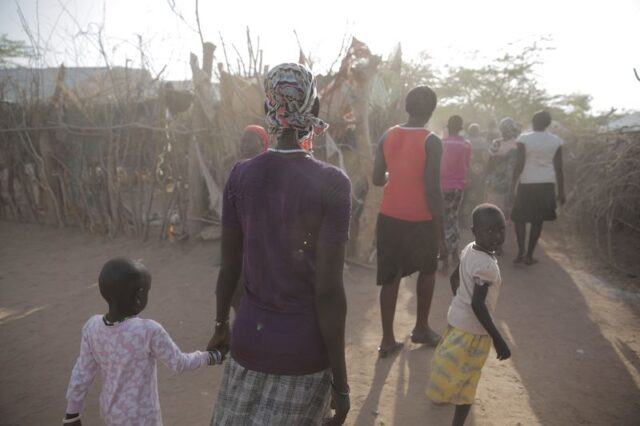At the end of 2016, 22.5 million refugees (defined as a person who has fled to another country) existed around the world. This is the largest number of refugees ever recorded, and this number still continues to grow.
With a crisis this big, there’s no surprise that there’s a lot of information about it. Unfortunately, this poses a new problem: How do people know what’s true, and what isn’t? It’s easy for myths and misinformation to spread and be taken as fact, but this only makes it harder for people who are displaced.
Embed from Getty Imageswindow.gie=window.gie||function(c){(gie.q=gie.q||[]).push(c)};gie(function(){gie.widgets.load({id:’mhDi5JRoTORFjGYFu9rKIg’,sig:’WQTQWHgUCEU-cFKISGr87byTmwFu_j8iYL8MdpXFak0=’,w:’594px’,h:’396px’,items:’951030652′,caption: true ,tld:’com’,is360: false })});
The best way to combat false information is to reveal truth. Many refugees face complicated situations – ones that don’t have easy answers – but facts will give us a chance to find those answers and help to put an end to the refugee crisis.
Here are eight common misconceptions about the refugee crisis, and the truth that disproves them:
Myth 1: Most of the world’s refugees are in wealthy countries
There’s a belief that the U.S. and many European countries shelter a substantial amount of refugees. In reality, the majority of the world’s refugees live in poor or middle-income nations. The UN’s Refugee Agency estimates that over eight in ten of the world’s refugees are sheltered by developing countries. Turkey, Pakistan, and Lebanon sheltered the highest number of refugees in mid-2016. These three countries combined hold 5.4 million refugees.
Myth 2: Most refugees are adults
Embed from Getty Imageswindow.gie=window.gie||function(c){(gie.q=gie.q||[]).push(c)};gie(function(){gie.widgets.load({id:’hHuakrmmShFAlwCaWRr8cA’,sig:’AvW1ee7V8xmUzpOGTgYjrja2g_xVfhhE4aEIouox2no=’,w:’594px’,h:’395px’,items:’825321700′,caption: true ,tld:’com’,is360: false })});
Becoming a refugee is an unbelievably difficult situation for anyone, but even more so for children. More than half of all refugees are children. That’s nearly one in every 200 children in the world. Many of these children are separated from their parents, meaning these children have to take care of themselves and even handle their own legal cases.
Myth 3: Refugees and migrants are the same thing
Though the two terms are sometimes used interchangeably, refugees and migrants are separate and distinct terms. Refugees are people who cannot safely return to their homes and are seeking protection from dangerous situations. The term “refugee” comes with a specific legal context that does not apply to all migrants.
As the UN Refugee Agency puts it, “conflating ‘refugees’ and ‘migrants’ can undermine public support for refugees and the institution of asylum at a time when more refugees need such protection than ever before.”
Myth 4: All refugees come from war zones
Embed from Getty Imageswindow.gie=window.gie||function(c){(gie.q=gie.q||[]).push(c)};gie(function(){gie.widgets.load({id:’-fK_QbkwSABjITPI03lyuw’,sig:’faTuIkzgnhyByz8Nj1ir3DW4kkfdrKclHrAAlLKtD6A=’,w:’594px’,h:’394px’,items:’961044668′,caption: true ,tld:’com’,is360: false })});
While most of history’s refugees have come out of war, other issues also contribute to the refugee crisis.
Persecution is among the most common reasons, which can take on many forms. Religious, social, national, racial, and political persecution have all led to refugees.
Growing hunger is another factor that has contributed to the crisis. Severe droughts in Northern Africa have created food instability, leading millions of people to become displaced in search of a reliable food source.
Myth 5: It’s easy for refugees to resettle into other countries
The difference between shelter and resettlement has a huge impact on refugees. Resettlement ensures that refugees have legal and physical protection, including access to rights and services similar to that of nationals. At the end of 2016, less than 1% of refugees were resettled into other countries. That means less than 1% of refugees are legally entitled to receive valuable resources from the nation they are in.
Myth 6: Refugees are an economic burden to other countries
Despite concern that refugees will pose financial problems to the nations they resettle in, research has found that accepting refugees actually boosts national economies. Some experts have argued that, though the initial cost of resettling can be high, accepting refugees is a good investment in the financial future of a nation.
Professor Alexander Betts of the University of Oxford points to Uganda for example. “In Kampala, the capital city, for instance, we found that 21 percent of the refugees have businesses that employ other people and 40 percent of those employees are citizens of the host country. In other words, refugees were creating jobs. Many of the businesses were, even in refugee camps, highly innovative and networked into the structures of the global economy.”
Also, in the United States, the average refugee becomes a net contributor to public coffers eight years after arrival. A study found that refugees actually pay back more in taxes than what they receive in benefits—about $21,000 more in the first 20 years in the USA.
Myth 7: Once a refugee is resettled in another country, things get easier
Embed from Getty Imageswindow.gie=window.gie||function(c){(gie.q=gie.q||[]).push(c)};gie(function(){gie.widgets.load({id:’LW9TkRcZTTdbDFdVtYXkEw’,sig:’cUJ6OIO4cpD-CrZwBga1loJ-KmylUMeGn9yAC0_Ccr8=’,w:’594px’,h:’396px’,items:’966938962′,caption: true ,tld:’com’,is360: false })});
The battle that refugees face doesn’t end once they settle into a new country. After resettlement, refugees encounter many issues in their new countries. These may include trauma, language barriers, financial problems, discrimination, and access to education. These obstacles can be even more difficult for children, who face huge challenges at very young ages.
Myth 8: There’s nothing I can do to help the refugee crisis
In a global situation this massive, it can feel like one person can’t make a difference, but this is not true. Everyday people can do a lot to help refugees. Volunteering, raising awareness, petitioning, donating, and more can be done to assist those affected by the refugee crisis.

